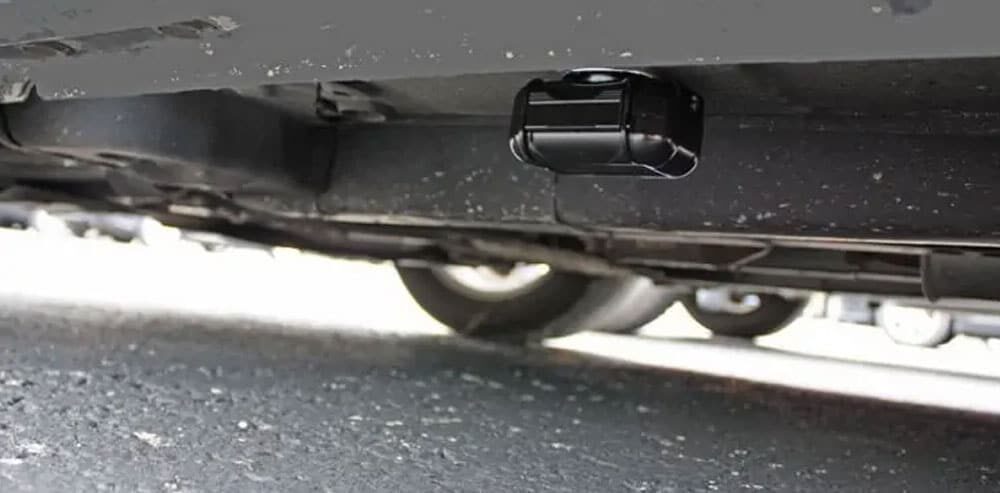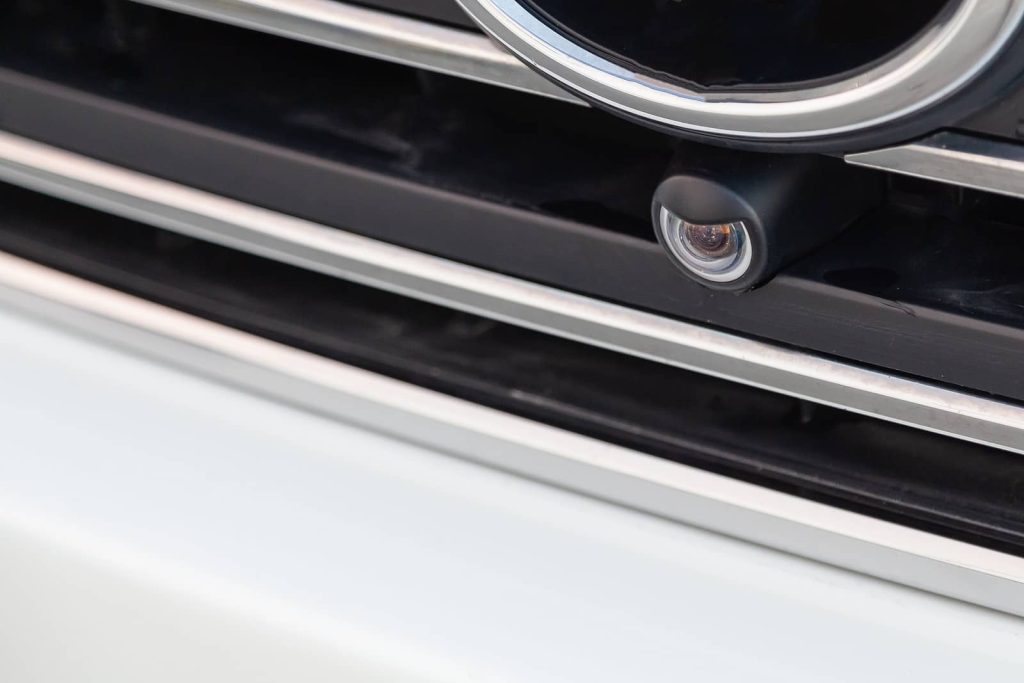How do Car Trackers Look Like?
Different GPS trackers have different designs; though they have a standard build. For instance, a portable battery-powered GPS tracker usually has a rectangular or square shape. Also, it could be equipped with a magnet case, for easy attachment on your vehicle.
On the other hand, for OBD trackers, they have a plug-like design which is perfect for attaching beneath a vehicle’s steering wheel. Finally, the hard wire GPS tracker features a few cables that connect to the car’s ignition & battery.
Here is a more detailed review of the different car tracking devices:
Portable Trackers
This is the most commonly used tracker, thanks to its small design which is equipped with an in-built rechargeable battery. Moreover, it could be connected to an external battery pack. It requires other accessories like a hard wire kit to help establish a connection to the car’s battery.
Therefore, when scanning for a tracking device in your vehicle, it’s crucial to search for a device small enough to contain a SIM card with a USB port equipped in it.
Hardwire Trackers
The most common place to attach this type of tracker is behind the vehicle’s dashboard. They have several cables which are linked to the battery of the vehicle and the ignition. Hence, if you suspect you are being tracked, it’s important to disassemble the dashboard.
Hardwire trackers are some of the most difficult to find because you have to disassemble your dashboard.
Plugin GPS Trackers
OBD trackers are the most common types of plugin trackers, and they are usually connected in the OBD port beneath the steering wheel. The OBD port is the computer interface port, generally used for special occasions like turning off the check engine light.
Installation calls for extra accessories like a y cable, which is installed inside the port, thus ensuring the plugin tracker is concealed.
Where to Scan for a Tracking Device in Your Car
If you believe your vehicle has a hidden tracking device, you’ll require several basic tools, such as a mat, a mechanic’s mirror, and a flashlight. The mat will help you slide under the car. However, if a mere visual scan won’t do the trick, you could require specialized gear like bug detectors or electronic sweepers.
Here is a brief overview of the steps included when scanning your car for a tracking device:
Exterior Inspection
Take your mirror and flashlight and inspect in areas like the wheels and under the car. Oftentimes, trackers are concealed in places that are easy to reach. Keep in mind that the tracker might be dirty, hence hard to locate.
Interior Inspection
Start by checking the data port; most trackers have a miniature size, so don’t be quick to omit plain sight areas like the trunk and seats.
Use a Bug Detector
You can purchase a bug detector in stores that sell GPS trackers. However, some trackers are designed to transmit when the car is on the move, so you can’t detect them using a bug detector unless the car is moving.
Seek Professional Assistance
If you believe someone is tracking your vehicle but can’t locate the tracking device, it would be best to hire a professional to help you out. They specialize in-vehicle systems, car alarms & audio systems, and they’ll have the necessary skills and gear.

How to Scan Your Car for a Tracking Device
Scanning your car for a GPS tracker is a multi-step process, and depending on where it is located, you might need more intricate equipment. That said, here is a comprehensive guide on how to scan your car for a tracking device:
Step 1: Locating the Tracking Device
To locate the tracking device, you have to inspect both the interior and exterior of your vehicle. When it comes to the exterior, you’ll have to look in areas like the wheels, under the hood, the front & back bumper, or the undercarriage.
On the other hand, when scanning the interior, you can search under the seats and floor mats, hatchback, or in the OBD port.
A few Pointers
- Tracking devices are usually positioned on your car’s exterior, where the individual who put it there can get it back easily.
- Use a flashlight and mirror to inspect under the car and check the odd corners and other hard-to-reach places.
- Inexpensive GPS trackers are designed to keep tabs on your locations, and this information has to be uploaded to a phone or computer later. However, more expensive options send frequencies remotely.
- Invest in a bug detector, or hire professionals to ensure your vehicle is bug-free.
Scanning Your Vehicle’s Exterior
Check for a Rectangle or Square-Shaped Device
As pointed out, GPS trackers have a standard build but different designs; and are just as big as a closed fist. More traditional trackers could feature an antenna, while others are magnetic. If you haven’t done this before, check your car manual to spot objects that didn’t come with your car.
Also, in this step, you’ll need your mirror and flashlight to check in the dark corners and edges. For those of us who’ve watched too many movies, keep in mind that tracking devices don’t look like loose or spare wires. A loose cable in the glove compartment or hood could simply mean that your mechanic did some shoddy work on your car, but it doesn’t necessarily point to a bug.
If you search and find a tracker, don’t fret. It could be your parents or spouse tracking you.
Search the Undercarriage
Take your floor mat and slide beneath your car to search the undercarriage. Use your flashlight to illuminate the car’s underside, and look for suspicious square-shaped gadgets, antennas, or objects stuck with tape under the car. Any temporarily attached object could be a tracking device.
If you have jack stands, you can use them to elevate your vehicle. This way, it will be much easier to inspect your vehicle’s underside. If you notice something peculiar, use your flashlight to double-check.
Most trackers are magnetic, so all you have to do is pull. For this reason, start with the gas tank because it’s made of metal, and it’s an easy place to place a tracker.
Scan the Wheel, Wells
When you’re done with the undercarriage, check the wheel wells. Scan beneath the metal or plastic guard that borders the upper half of the wheel. If there’s a tracker here, it’ll stand out like a sore thumb.
If your car has hubcaps, pop them out using a flathead screwdriver to see if there’s a tracker hidden there. Fortunately, you don’t have to detach the wheels to scan the wheel wells but feel free to detach them if you want to be thorough.
Look In the Bumpers
The front & back bumpers are a common hiding place for tracking devices. Typically, bumpers are hollow, so get down there with your mirror and take a peek. Also, you can use your fingers to feel the rim’s interior; if you find something, pull it.
In extreme instances, a tracking device could be connected beneath the front bumper and to the vehicle’s electrical system. To be sure there’s no foul play, compare your car’s wiring to the wiring manual.
Check the Roof
This is mostly for those of us with taller vehicles like a van, SUV or truck. The tracking device could have been put on the roof. So, make use of your ladder and get to your vehicle’s roof and inspect from different angles to spot anything amiss.
Check the Hood
Pop the hood, then check if there are any tracking devices attached. You can also compare it to similar car models online for best results. Also, scan the hood panel’s underside.
It would also be a good idea to check your car model’s engine picture online to spot potential bugs. However, don’t disassemble the components ignorantly. Identify the tracker, if any, and then gently pull it out to ensure there are no damages to the car.
The front part of your vehicle is made of metal and is inspected on a regular basis; therefore, it’s not the most ideal place for someone to place a tracker. Therefore, there is a high chance you won’t find one there.
If, so far you haven’t found a tracking device, you could be in the clear. However, to be safe, proceed to the next step.

Hire A Private Investigator for A Bug Sweep (Available Nationwide)
Notice: Our Bug Sweep services to check for monitoring devices and hidden cameras are exclusively available in all 50 States.
To hire a private investigator for monitoring devices and cameras, you will need to contact our office @ (800)-577-1080, to arrange a time for our investigators to visit your residence. Please note that we do not service apartment buildings. Our team will thoroughly inspect your home for any hidden cameras or surveillance equipment.
We conduct inspections for vehicles Monday through Saturday at 11:00 a.m. at our corporate office located at 620 Newport Center Drive, Suite 1400, Newport Beach, CA 92660. You must prepay the fee of $1500.00. The easiest way is through Zelle into our Wells Fargo account using the access code of our email address tmartin@martinpi.com. You can also send in a check, and we will wait until it clears.
#2 Scan Your Vehicle’s Interior
Check the OBD Port for a Plugin Tracking Device
If you haven’t found a tracker on the exterior, it could be in the interior. You should begin with the OBD port since it is the most common place in the car’s interior for someone to place a tracker. This is because the plugin tracker can use your vehicle to power itself. These tracking devices are incredibly accurate since they can access OBD information.
Check your vehicle’s manual to locate the OBD port’ though it’s commonly underneath a panel, beneath the steering wheel. The OBD port should have anything plugged in. Your car should have 16 open ports with a broad mouth at the center, similar to a VGA cable.
Unless you think the person tracking you has access to your vehicle, it’s unlikely that there’s a tracking device in your car. Someone attaching a tracker would prefer positioning it where they can easily retrieve it.
Scan the Storage Compartment, Holster & Every Pouch
Open the glove compartment and the section on the armrest. Check all storage sections on the door’s interior side, as well as the pockets on every seat’s back side. It’s possible someone placed a tracker on any of these areas, precisely if they were trying to be sly when you gave them a lift.
When it comes to the glovebox, you’ll have to remove everything in it one by one, and you’ll even get the chance to finally organize it when you’re done looking for bugs.
Check in the Upholstery
If you are able to access your upholstery, you should check it. Unzip the headrests and cushions as well, and also scan underneath all detachable parts. Moreover, if your vehicle has seat covers, remove them to check whether there is a tracking device tucked under them.
Look Under the Floor Mats and Seats
The next area you need to check is under the mats and seats. Take your flashlight and illuminate under each seat, and even use your fingers to feel the bottom for trackers. If you suspect you’ve found a tracking device, compare how the front seat and back seats look for possible anomalies.
Check In the Spare Wheel Well & Trunk
The last areas you need to check are the trunk and wheel well of the spare wheel. Open the trunk and concentrate on the minor crevices beneath the back window before moving on to the other sections. When done, check the other trunk areas, and then remove the spare wheel, and check the well carefully.
#3 Use Apps, Bug Detectors & Experts
If you have searched the interior and exterior of your car using your fingers, flashlight, and mirror and haven’t found anything, it’s time to upgrade your technique. Here is how to detect GPS tracking devices in your car:
Request Your Mechanic to Scan for a Tracking Device
If you still suspect there’s a tracker in your car, then you should request your mechanic to check it for you. The good thing about asking your mechanic to find a tracker in your car is that they’ll be able to spot it easily since they know what should be in your car and what shouldn’t. Also, if there is a tracker in there, they’ll definitely find it.
Nonetheless, if you aren’t confident with your mechanic’s findings, request a private investigator or someone who installs car alarms to scan your car.
Check Your Phone for Apple Airtag Alerts
If you don’t know how to scan your car for a tracking device with your phone, then you’ve come to the right place!
If your iPhone keeps getting alerts from Apple Airtag while driving, there is a high chance that someone has put an Apple Airtag in your car. To locate the tracker, go to the Find My Phone app, click alert, continue, and tap “play sound.” The tracker will continue beeping until you find it.
Nonetheless, if you don’t have an iPhone, you can use your Android phone to search for Airtags by downloading a Tracker Detect software. Tap “scan” to scan your car for Airtags.

Sweep Your Vehicle
You should also consider sweeping your vehicle electronically using a bug detector. Gadgets that transmit your location actively can be located using a handheld detector that’s designed to search for radio frequencies (RF).
You can purchase a bug detector in a spy or surveillance shop or go online. Once you purchase it, follow the guidelines included to sweep your car for tracking devices.
The tracking device may transmit infrequently or when the vehicle is moving, thus you may want to sweep for bugs with ignition switched on.
If you haven’t found a tracking device so far, then you can be certain that there aren’t any trackers. On the other hand, if you do find a GPS tracker, there are a few ways you can deal with it, which is what we’ll cover in the section below.
How to Block Car Tracking Devices
So, how can you block vehicle GPS tracking? There are a few ways to go about it, including:
Utilize a Plug-In GPS Blocker
These types of GPS blockers establish an interface signal ideal for blocking car GPS tracking. All you have to do is plug it in the auxiliary power port, and once you turn the ignition on, the plug-in GPS blocker also switches on and your car disappears from all trackers. To disengage it, turn off the ignition.
Read the product description before buying to see if the blocker offers a range wide enough to meet your needs. Usually, the high-end tracking devices block signals within a larger radius than the inexpensive options.
Note: It is not illegal to have a GPS blocker, though it’s illegal to utilize one in some scenarios as they can obstruct emergency communications.
Have a Handheld GPS Blocker
You can also carry a GPS blocker with you since it will jam all GPS signals as long as you have it. It’s rather different from the plug-in option because you don’t have to plug it into your car. You simply have to manually activate it with the push of a button.
Make sure you deactivate it once you stop driving, because it’ll continue to interfere with cell and GPS signals around you.
As with the plug-in option, using this GPS blocker could be termed illegal in some instances, especially if it interferes with emergency communications.
Cover the Tracker with Aluminum Foil
This might be the most practical technique for most people. Generally, electrically conductive metal will interfere with a tracking device’s signal. Moreover, this is an easy, legal, and affordable option.
Therefore, when you don’t want your location to be known, you can cover the tracker using aluminum foil. This will be especially easy because you’ve already located the tracker in your car.
Additionally, placing the GPS tracker in a metal box can block it. But this only works if you can remove the tracker and put it in the box.
Detach the Battery of the Tracking Device
You should remove the battery of the tracking device, because without it, it can’t transmit signals. Now that you’ve already done the heavy lifting and located the tracking device, all you have to do is remove the batteries.
If the tracker is attached to your car via a data connector plug or a magnet, just pull it out and detach the battery to halt signal transmission. Next, throw away the battery and tracking device to make sure it doesn’t go on to signal your location.
Nevertheless, if the tracker is hardwired to the car, it would be best to hire a mechanic to detach it to avoid damaging your vehicle.
Keep Safe by Investing in a GPS Tracker Detector
These tracking devices can be handy for law enforcement, private investigators, and companies, though for the average person, they are seen as a way of invading someone’s privacy. To find a tracking device, do an internal and external sweep.
For additional safety, buy a GPS tracker detector, as it will alert you of a signal emitted from tracking devices, and it’ll help you find the tracker.
Related Questions
Why Use a Concealed Tracking Device?
There are a handful of reasons why someone would opt to use a concealed tracking device; some are legitimate, and others not so much. Law enforcement uses these devices when they have a warrant, which is also the case with private investigators.
In addition, it could be your parents tracking you to make sure you’re safe, or a suspicious spouse who wants to catch you in the act.
The main uses for tracking devices are:
- Theft recovery.
- Tracking your teenage child.
- Taxi & delivery dispatch.
- Fleet management
Where can I Purchase GPS Tracker Blockers?
There are many stores where you can purchase GPS tracker blocking devices including specialty stores where private investigators shop. Also, you can find them online in shops that deal with electronics like surveillance gear and GPS gadgets.
Final Word
So, how can you scan your can for a tracking device?
- Look for it on the exterior, in areas like the undercarriage, wheel wells, bumpers, hood, and roof.
- Search the interior, including the OBD port, upholstery, storage compartment, pouches, holster, and under the seats.
- Use bug detectors, apps, and experts.
Having read this article, you are now armed with incredible knowledge in case someone slyly attaches a tracking device on your vehicle. Also, you now know how to block vehicle GPS tracking, but we highly recommend using an aluminum foil or removing the tracking device’s battery.
For more information, feel free to contact us!
SCAN YOUR CAR FOR A TRACKING DEVICE
In this era where it’s all about technology, tracking devices have become smaller and less traceable. These small but handy devices are used to locate anything from your luggage to lost car keys despite their location.
Additionally, tracking devices are useful security devices for mobile gadgets like cars since you can easily locate them in case they get stolen. And while their small & undetectable size is advantageous in such a case, it would be rather frustrating if you suspect your car has a tracking device. The process of locating it is rather cumbersome.
That said, trackers mainly work using Bluetooth or other wireless technology to send signals to the owner, regardless of distance. But, if you suspect your car has a tracker, and you don’t know who’s tracking you, how can you scan your car for the tracking device? It’s quite an interesting process, and it involves a handful of interesting toys.






